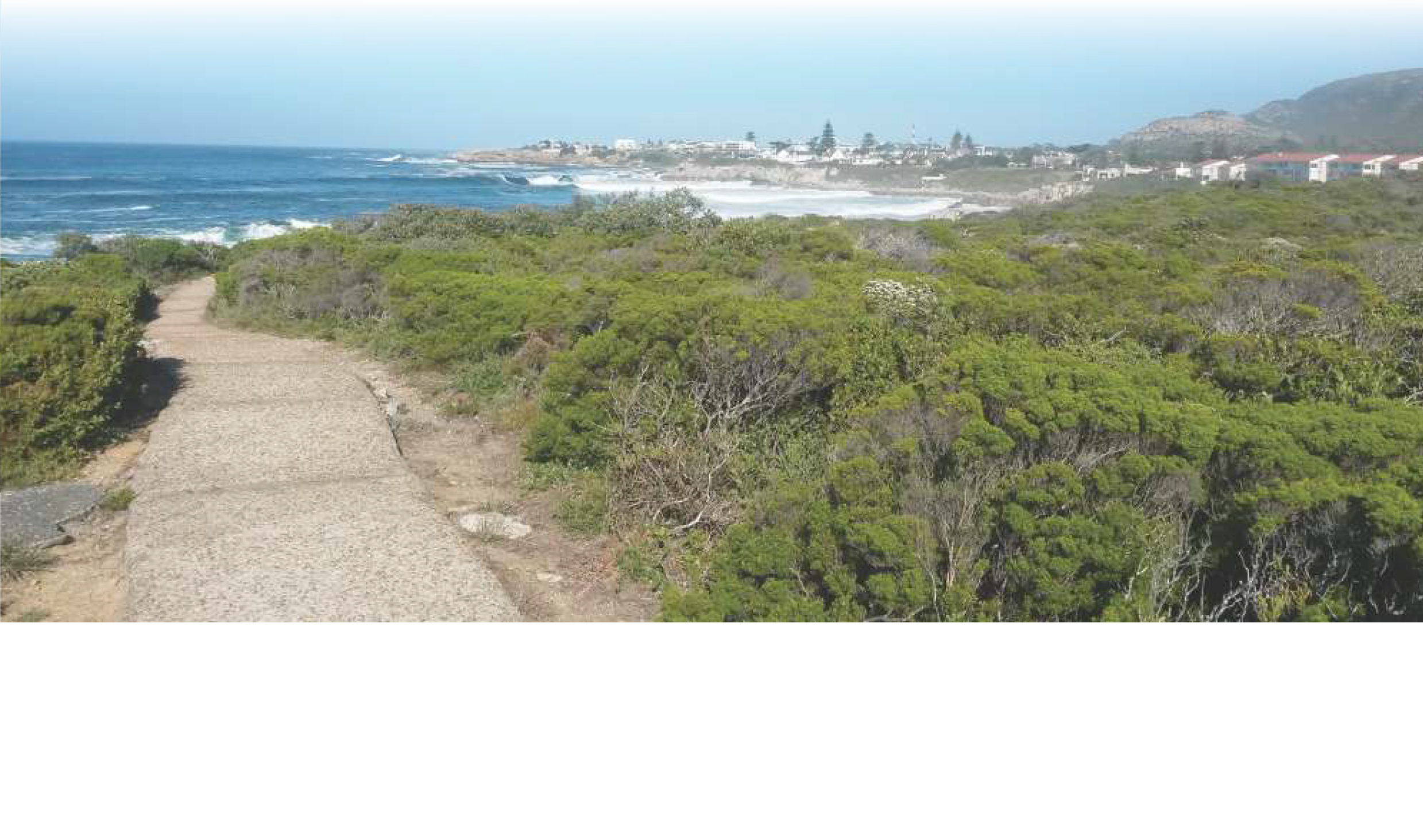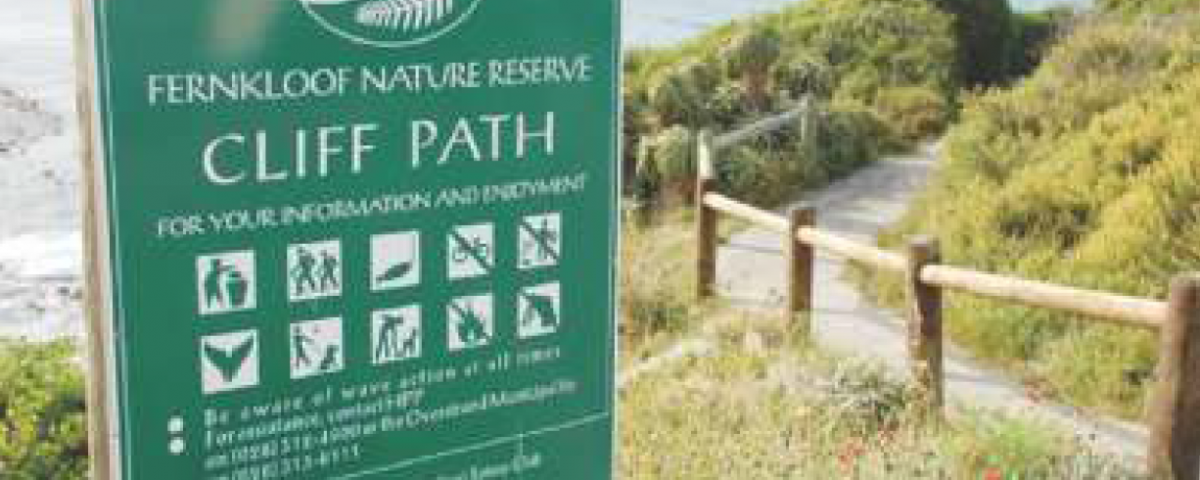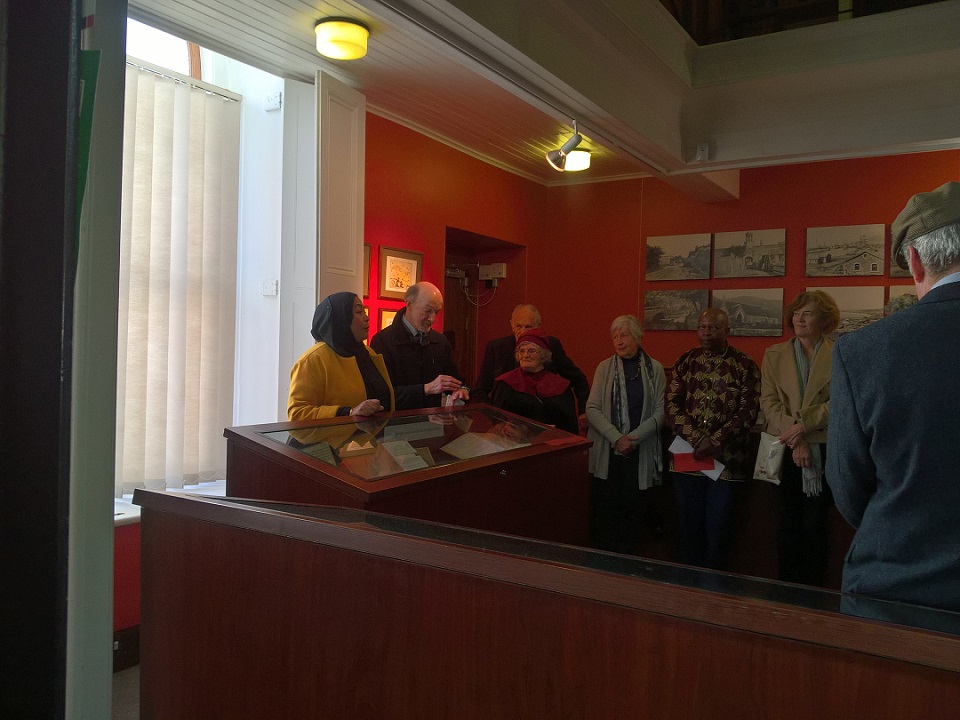
The Van Riebeeck Society for Southern Africa 1918-2018
September 18, 2018
RE-THINKING HERMANUS HISTORY: ECONOMIC GROWTH IN A UNIQUE SOUTH AFRICAN TOWN PRESENTED BY ROBIN LEE
October 2, 2018The Cliff Path in Hermanus is currently the most frequented tourist attraction in the town. It offers a safe and enjoyable walk of 12 kilometres from the New Harbour in the west to the Klein River Estuary (the lagoon) in the east. The fore-runners of the Cliff Path were dozens of informal paths made and used by fishermen going to specific fishing points. It follows that a significant number of the place names along the Cliff Path have links with fishing.
One of the advantages of the Path is that it can be accessed by car and on foot at many points of interest, so you do not have to commit to the entire 12 km at once. You can walk portions of it on different occasions. Also, some sections are wheelchair-friendly, especially those nearer the Old Harbour and on Hoy’s Koppie.
The process leading to the creation of the Cliff Path was started in 1960 by Eric Jones, an RAF airman who had been stationed in Hermanus in WWII and settled here after the War. He proposed the idea at a Hermanus Botanical Society meeting, where it was immediately supported. The first Cliff Path, shorter and more informal than the present Path, was physically constructed by Jones, Dr Ion Williams and members of the Hermanus Botanical Society.
Early in the present century, David Beattie who has family connections with Hermanus, retired here and set up the Cliff Path Management Group to make a private sector contribution to the preservation of the Path, some parts of which had fallen into disrepair. Over the past 17 years the Group has raised and spent more than R3 million on improving and extending the Path. They work closely with the Municipality, which funds some aspects of the work.
Now the Hermanus History Society and the Cliff Path Management Group are co-operating to research the origin and meaning of all the place names along the Path. Part- funding of the project has been made available by Sumaridge Wine Estate.
Please contact Robin Lee if you have more or different information about these names on 028 312 4072 or robinlee@hermanus.co.za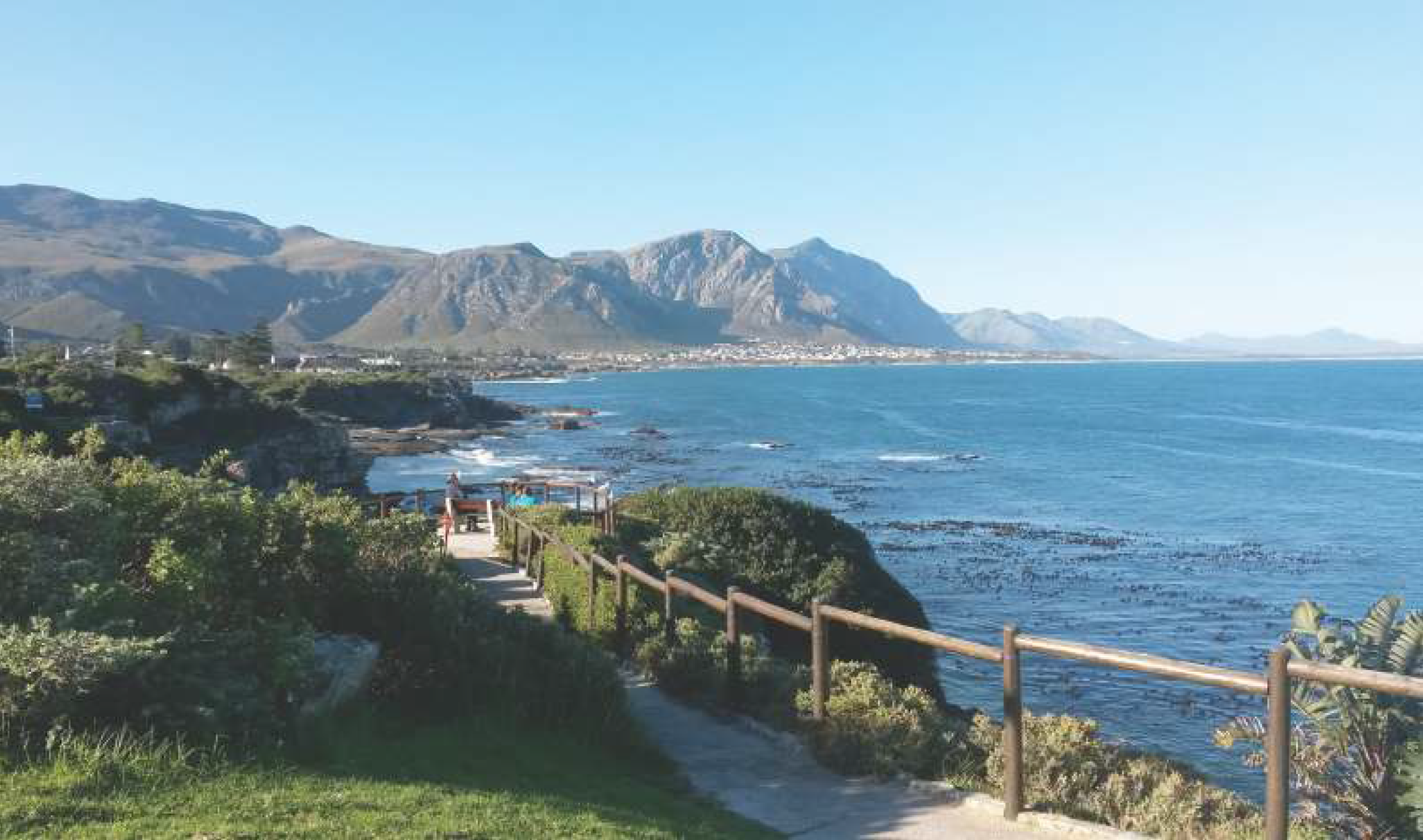
What to see along the Cliff Path
To ensure protection of its fragile ecosystem, the Cliff Path and the fynbos vegetation through which it passes was incorporated into the proclaimed Fernkloof Nature Reserve in 2000.
The Cliff Path not only affords some of the best land-based whale watching in the world from June to December, but is also a nature lover’s paradise. Along with a diversity of vegetation types, several coastal mammals and birds can be spotted on the Cliff Path:
Mammals – Cape Clawless Otter (early morning, late afternoon), Caracal (very rare), Chacma Baboon, Grysbok (primarily nocturnal), Large and Small Spotted Genet (nocturnal), Porcupine (nocturnal), Rock Dassie, Small Grey Mongoose, and Striped Mouse.
Birds – African Black Oystercatcher, Amethyst Sunbird, Barthroated Apalis, Cape Batis, Cape Bulbul, Cape Spurfowl, Cape Sugarbird, European Swallow, Forktailed Drongo, Grassbird, Hadeda Ibis, Gulls (Kelp, Hartlaubs & Greyheaded), Karoo Prinia, Lesser Double-collared Sunbird, Malachite Sunbird, Olive Thrush, Orangebreasted Sunbird, Robin Chat, Sandwich Tern, Sombre Greenbull, White-breasted Cormorant and Spotted Eagle Owl.
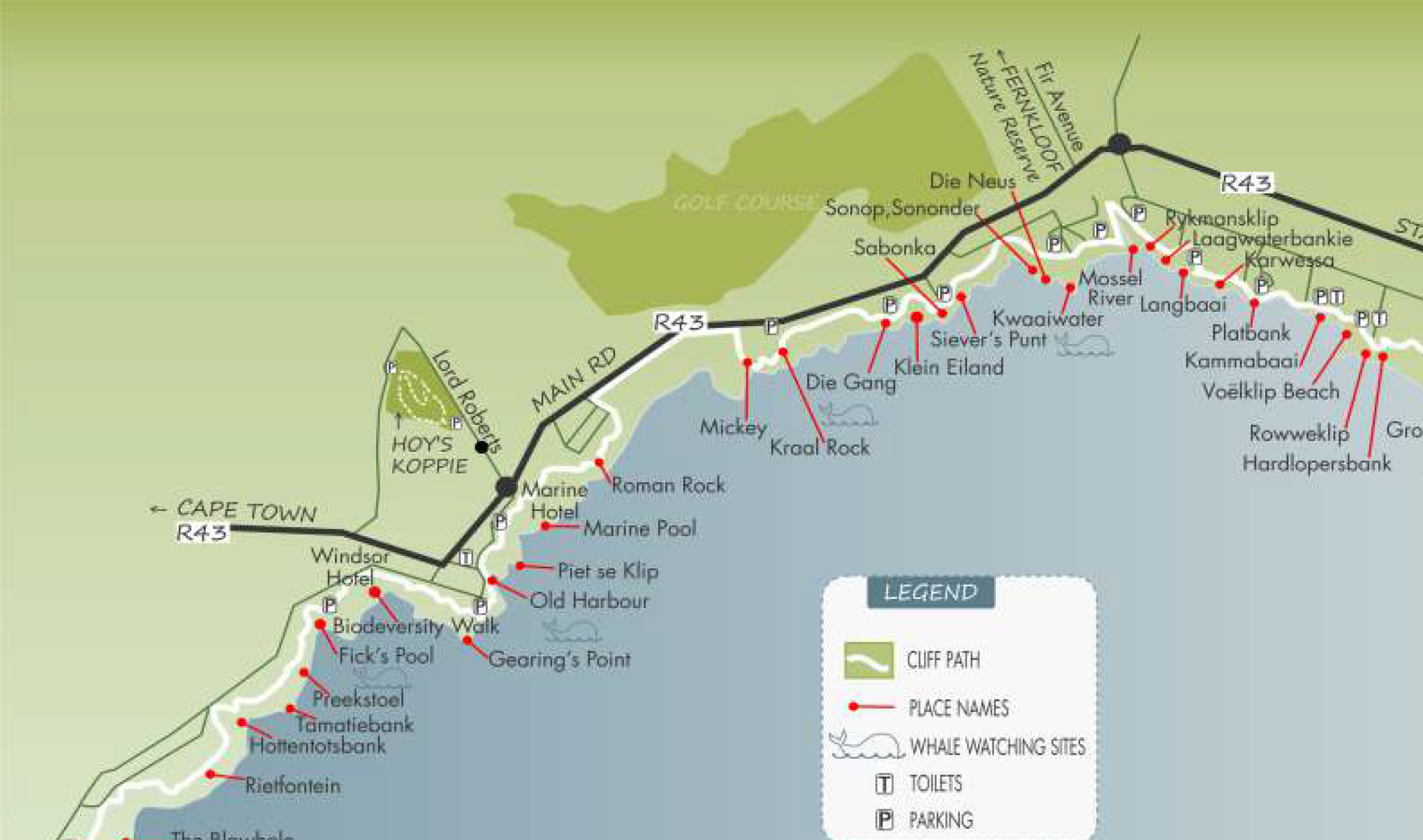
■ Scotsman’s Point (Skotsmans Punt) – Near the New Harbour, rocks at this point make it possible to look over the fence and view the activities in the New Harbour without paying an entry fee to get in through the gate.
■ The Blowhole (Blaasgat) – The blowhole was a feature of Stil Bay before the New Harbor was built there. Waves crashed into a low cavity in the rocks at this point. Air in the ‘hole’ was compressed and escaped noisily through a fissure in the rocks. This blowhole is now submerged.
■ Rietfontein (Reed fountain) – This area is a wetland fed by a subterranean spring (fontein). The water supports growth of reeds (riet). The European settlers camped here on arrival in Hermanuspietersfontein in1857.
■ Hottentotsbank – Named after a species of fish that were caught in numbers off the rocks at this point.
■ Tamatiebank (Tomato bank) – Oxidation of the rocks at this point gives them a pink colour, not unlike a half-ripe tomato.
■ Preekstoel (Pulpit) – A high rock in the shape of a church pulpit.
■ Fick’s Pool – There are two versions of the origin of this name. In one, a school principal in the 1930s persuaded the Municipality to build a pool here for use mainly by high school pupils who could not easily access Grotto Beach. In the other version, a retired gentleman named Fick bathed here so regularly that the pool was named after him.
■ Biodiversity Walk – On this stretch between Fick’s Pool and Gearing’s Point you’ll find: Hermanuspietersfontein – A spring (fontein) named after an itinerant school teacher, Hermanus Pieters, who camped at this spot and from whom the town of Hermanus, (originally Hermanuspietersfontein) gets its name. Wasbakkies – In early Hermanus all surface water was coloured brown by tannins from the fynbos. Clear water came only from the natural streams bubbling up in places. The Municipality built concrete structures where white laundry items from the Sanatorium and hotels could be washed without becoming brown. Die Piering (The Saucer) – a saucershaped bay within the larger Walker Bay.
■ Hermanuspietersfontein - A spring (fontein) named after an itinerant school teacher, Hermanus Pieters, who camped at this spot and from whom the town of Hermanus, (originally Hermanuspietersfontein) gets its name. Wasbakkies – In early Hermanus all surface water was coloured brown by tannins from the fynbos. Clear water came only from the natural streams bubbling up in places. The Municipality built concrete structures where white laundry items from the Sanatorium and hotels could be washed without becoming brown. Die Piering (The Saucer) – a saucershaped bay within the larger Walker Bay.
■ Gearing’s Point – Named for Sydney Gearing, a prominent citizen and engineer who regularly holidayed in Hermanus in the late 19th and early 20th centuries. Around Gearing’s Point you’ll find the Boiling Pot, a small offshore island of rugged rocks around which, in rough seas, the water churns as if boiling; Castle Rock, a tall guanocovered rock that resembles castle battlements; and Die Kombuis (The Kitchen). The origin of this name is unknown.
■ Old Harbour – Today a National Monument and open-air museum commemorating the involvement of the town with the fishing industry from its origins in 1855 until all fishing activity moved to the New Harbour in the 1950s.
■ Piet se Klip – Origin uncertain, but probably the favourite fishing spot of a fisherman named Piet.
■ Marine Pool – A public tidal pool below The Marine Hotel, it was once known by residents as ‘Bientang se baaigat’. Bientang was regarded as the last of the Khoisan people in Hermanus and was reputed to live in a nearby cave.
■ Roman Rock – A popular fishing spot where the rock formation below creates conditions favoured by the Red Roman fish that were prolific off this rock.
■ Mickey – Origin unknown.
■ Kraal Rock – Legend has it that members of the leper colony in the Hemel-en-Aarde Valley grazed their sheep and cattle nearby and kept them in a kraal (corral) at this spot.
■ Die Gang (The passage) – Here a narrow channel separates a rocky outcrop from the mainland. At one time a connecting concrete bridge was constructed to give fishermen access to the seaward side of the island.
■ Klein Eiland (Small Island) – a flat rock offering a good fishing place, which has a concrete bridge linking it with the rocky shore.
■ Sabonka – There are two possible origins of the name: Either it is the nickname of a gillie who fished here or it is derived from a Shangaan or Tswana word. No evidence can be found to support either explanation.
■ Siever’s Punt – The favourite fishing spot of a wealthy resident by the name of Siever.
■ Sonop, Sononder (Sunrise, Sunset) – In summer months the sun rises to the left or east, and sets to the right or west of this spot as you face the sea.
■ Die Neus (The Nose) – A part of the rock formation at Kwaaiwater rocks, which resembles a nose protruding into the bay.
■ Kwaaiwater (Angry Water) – Named for the unusually rough seas crashing against the rocks at this point.
■ Mossel River (Mussel River) – The mouth of the small river of this name that has its source in the Fernkloof Nature Reserve. Large numbers of black mussel shells are regularly deposited by the sea on the beach here.
■ Local fishermen named two prominent rocks along the coast between Mossel River and Langbaai. They are: Rykmansklip (Rich man’s Rock), so named because a fisherman had to be ‘wealthy’ to afford the cost of continually replacing the fishing tackle lost at this point, and Laagwaterbankie (Low tide rock), accessible for fishing only at low tide.
■ Langbaai (Long Bay) – a long, narrow bay affording safe bathing.
■ Karwessa – A once popular fishing spot probably named after a fish species.
■ Platbank (Flat Rock) – Another once popular fishing spot.
■ Kammabaai – Possibly a secondary or offshoot bay to Voëlklip. Another story connects the name with two 1970s schoolgirls, being a combination of letters in their names.
■ Voëlklip (Bird Rock) – The roosting place of many birds, predominantly cormorants, it derives its name from this once guano-covered rock that serves to protect the safe bathing beach.
■Rowweklip – The water surrounding the rocks is very rough (rof).
■Hardlopersbank (Runners rock) – A flat rock from which fishermen frequently had to retreat hastily to avoid being swept away by the waves.
■ Grotto Beach (Originally Riviera Beach) – Riviera Beach was named for the Riviera Hotel near the Lagoon. This stretch of safe bathing beach gets its present name from the grottos, or caves, in the cliffs near the beach.
■ Piet-se-bos – A natural milkwood forest named after Piet ‘Orgie’ Geldenhuys, a well-known resident and relation of the Bishop family of Voëlklip.
■Kleinriviermond (Klein River Mouth) – The estuary of the Klein (Small) River that has its source in the Kleinriviersberge and runs through the village of Stanford into the lagoon.
